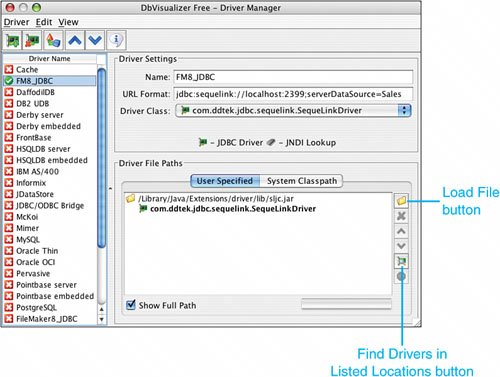

- #Dbvisualizer db file location how to#
- #Dbvisualizer db file location zip file#
- #Dbvisualizer db file location drivers#
- #Dbvisualizer db file location driver#
- #Dbvisualizer db file location password#
The following sections describe the steps for installing a JDBC Driver, and also how to configure DbVisualizer to use JNDI to obtain a database connection. This context is then used to lookup a database connection.
#Dbvisualizer db file location driver#
To enable database "lookup's" using JNDI, an Initial Context implementation must be loaded into the DbVisualizer Driver Manager.
#Dbvisualizer db file location drivers#
It does not replace JDBC drivers but rather adds an alternative way to get a handle to an already established database connection. This technique is widely used in enterprise infrastructures, such as application server systems. It is also possible to obtain a database connection using the Java Naming and Directory Interface (JNDI). To establish a connection to a database, DbVisualizer loads the driver and then gets connected to the database through the driver. A JDBC driver implements all details for how to communicate with a specific database and database version, and there are drivers available from the database vendors themselves as well as from third parties. All JDBC drivers conform to the JDBC specification and its standardized Java programming interfaces. That job is done by a JDBC driver, which is a set of Java classes. DbVisualizer does not deal directly with how to communicate with each database type.

ĭbVisualizer is a generic tool for administration and exploration of databases.
need to add a Driver that does not exist in the list of default drivers. need to have several versions of the same JDBC driver loaded simultaneously,. want to learn how the Driver Manager in DbVisualizer works,. If, however, any of the these things apply to you, keep on reading: If a JDBC driver for your database is bundled with DbVisualizer, see Driver Info on the Supported Databases page, you typically do not need to read this chapter. This is because the tnsnames.This page describes the way JDBC drivers are managed in DbVisualizer. Check if the environment variable ORACLE_HOME is defined. You have updated to the newest version of DbVisualizer. If not, check all steps and a few other things: (SOURCE=(METHOD=file)(METHOD_DATA=(DIRECTORY="C:\ADW"))) If using the file path alone does not work, use the following string instead:. 
Scroll to parameter _location, enter " C:\ADW", and click Apply Switch to the Properties Tab and Driver Properties.
#Dbvisualizer db file location password#
Enter Database Userid and Database Password that your OAC ADW admin provided. If not, check Configure connection files above. Y ou should be able to pick TNS Alias from a dropdown list that contains the OAC. Select Database Driver = Oracle OAC (or what you named it to earlier) and Service = TNS. Launch or relaunch DbVisualizer and create a new Connection using the Connection Wizard. Repeat the process for every OAC ADW environment (prod, test, etc). If you can't edit that remote file, copy its content and append it to the local file. If your OAC ADW admin allows you to edit that file, copy the content of the tnsnames.ora file in your wallet file path ("local tnsnames.ora file") and append to the end of that remote file. Note: if your machine already has TNS_ADMIN set, check if that path already contains tnsnames.ora ("remote tnsnames.ora file"). Edit system environment variable to set TNS_ADMIN = "C:\ADW" to tell DbVisualizer where to find tnsnames.ora file (the configuration file that defines the Oracle database address). WALLET_LOCATION = (SOURCE = (METHOD = file) (METHOD_DATA = (DIRECTORY="C:\ADW")))SSL_SERVER_DN_MATCH=yes Edit DIRECTORY part in sqlnet.ora to match the wallet file directory:. 
C:\ADW):Ĭwallet.sso, ewallet.p12, keystore.jks, ojdbc.properties, sqlnet.ora, tnsnames.ora, truststore.jks
Unzip and save the Wallet Zip to a safe path (e.g. Add the JAR files downloaded in step 1 for the driver entry. Rename the new Oracle (copy) entry to Oracle OAC (or whatever name you find good). In the Driver menu, select Duplicate Driver. In DbVisualizer open Tools -> Driver Manager select the Oracle Thin driver entry in the left list. Oraclepki.jar, osdt_cert.jar, and osdt_core.jar Visit Oracle download page to get three Java packages (Oracle account required):. In order to use the Wallet you will need some additional JAR files to be added for the Oracle Driver in DbVisualizer. #Dbvisualizer db file location zip file#
Wallet zip file downloaded from the Oracle Analytics Cloud Autonomous Data Warehouse (OAC ADW) admin.ĭownloading and Preparing the JDBC Driver.Modified on: Tue, 12 Apr, 2022 at 9:45 PM Solution home Database Specific Oracle Oracle: Connecting to Oracle Analytics Cloud Autonomous Data Warehouse using Oracle Wallet








 0 kommentar(er)
0 kommentar(er)
